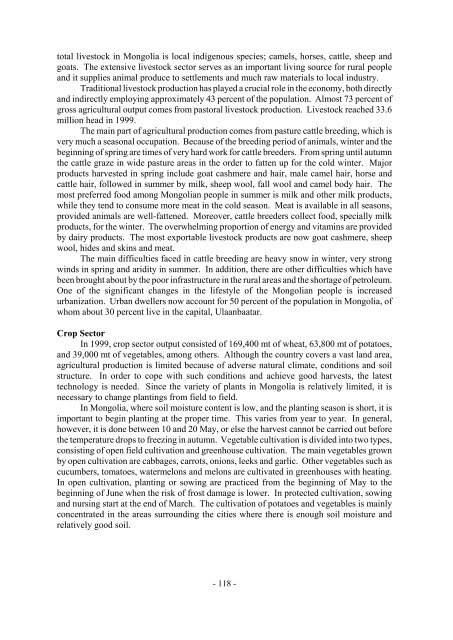Development of Agribusiness Enterprises - Asian Productivity ...
Development of Agribusiness Enterprises - Asian Productivity ...
Development of Agribusiness Enterprises - Asian Productivity ...
Create successful ePaper yourself
Turn your PDF publications into a flip-book with our unique Google optimized e-Paper software.
total livestock in Mongolia is local indigenous species; camels, horses, cattle, sheep and<br />
goats. The extensive livestock sector serves as an important living source for rural people<br />
and it supplies animal produce to settlements and much raw materials to local industry.<br />
Traditional livestock production has played a crucial role in the economy, both directly<br />
and indirectly employing approximately 43 percent <strong>of</strong> the population. Almost 73 percent <strong>of</strong><br />
gross agricultural output comes from pastoral livestock production. Livestock reached 33.6<br />
million head in 1999.<br />
The main part <strong>of</strong> agricultural production comes from pasture cattle breeding, which is<br />
very much a seasonal occupation. Because <strong>of</strong> the breeding period <strong>of</strong> animals, winter and the<br />
beginning <strong>of</strong> spring are times <strong>of</strong> very hard work for cattle breeders. From spring until autumn<br />
the cattle graze in wide pasture areas in the order to fatten up for the cold winter. Major<br />
products harvested in spring include goat cashmere and hair, male camel hair, horse and<br />
cattle hair, followed in summer by milk, sheep wool, fall wool and camel body hair. The<br />
most preferred food among Mongolian people in summer is milk and other milk products,<br />
while they tend to consume more meat in the cold season. Meat is available in all seasons,<br />
provided animals are well-fattened. Moreover, cattle breeders collect food, specially milk<br />
products, for the winter. The overwhelming proportion <strong>of</strong> energy and vitamins are provided<br />
by dairy products. The most exportable livestock products are now goat cashmere, sheep<br />
wool, hides and skins and meat.<br />
The main difficulties faced in cattle breeding are heavy snow in winter, very strong<br />
winds in spring and aridity in summer. In addition, there are other difficulties which have<br />
been brought about by the poor infrastructure in the rural areas and the shortage <strong>of</strong> petroleum.<br />
One <strong>of</strong> the significant changes in the lifestyle <strong>of</strong> the Mongolian people is increased<br />
urbanization. Urban dwellers now account for 50 percent <strong>of</strong> the population in Mongolia, <strong>of</strong><br />
whom about 30 percent live in the capital, Ulaanbaatar.<br />
Crop Sector<br />
In 1999, crop sector output consisted <strong>of</strong> 169,400 mt <strong>of</strong> wheat, 63,800 mt <strong>of</strong> potatoes,<br />
and 39,000 mt <strong>of</strong> vegetables, among others. Although the country covers a vast land area,<br />
agricultural production is limited because <strong>of</strong> adverse natural climate, conditions and soil<br />
structure. In order to cope with such conditions and achieve good harvests, the latest<br />
technology is needed. Since the variety <strong>of</strong> plants in Mongolia is relatively limited, it is<br />
necessary to change plantings from field to field.<br />
In Mongolia, where soil moisture content is low, and the planting season is short, it is<br />
important to begin planting at the proper time. This varies from year to year. In general,<br />
however, it is done between 10 and 20 May, or else the harvest cannot be carried out before<br />
the temperature drops to freezing in autumn. Vegetable cultivation is divided into two types,<br />
consisting <strong>of</strong> open field cultivation and greenhouse cultivation. The main vegetables grown<br />
by open cultivation are cabbages, carrots, onions, leeks and garlic. Other vegetables such as<br />
cucumbers, tomatoes, watermelons and melons are cultivated in greenhouses with heating.<br />
In open cultivation, planting or sowing are practiced from the beginning <strong>of</strong> May to the<br />
beginning <strong>of</strong> June when the risk <strong>of</strong> frost damage is lower. In protected cultivation, sowing<br />
and nursing start at the end <strong>of</strong> March. The cultivation <strong>of</strong> potatoes and vegetables is mainly<br />
concentrated in the areas surrounding the cities where there is enough soil moisture and<br />
relatively good soil.<br />
- 118 -
















